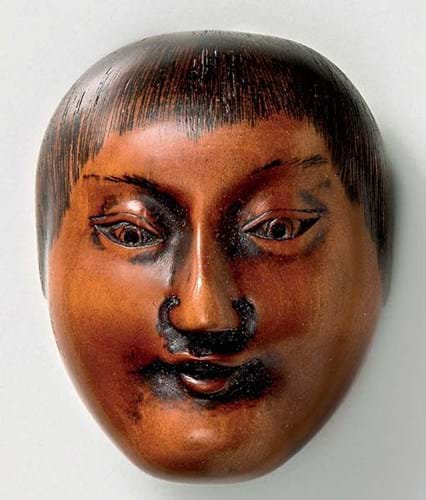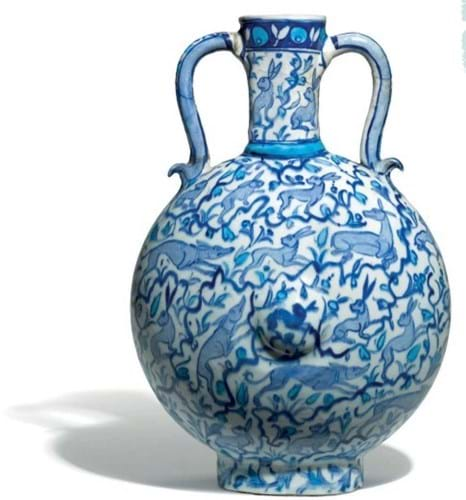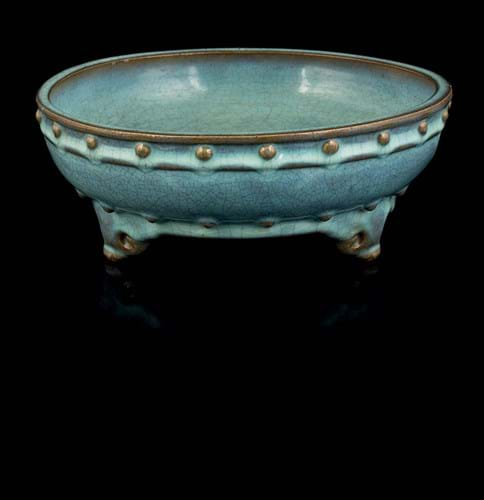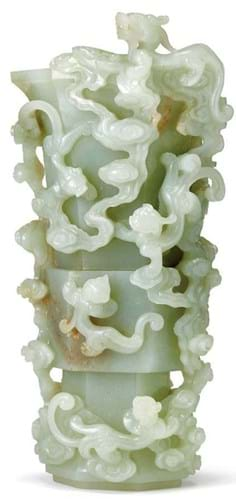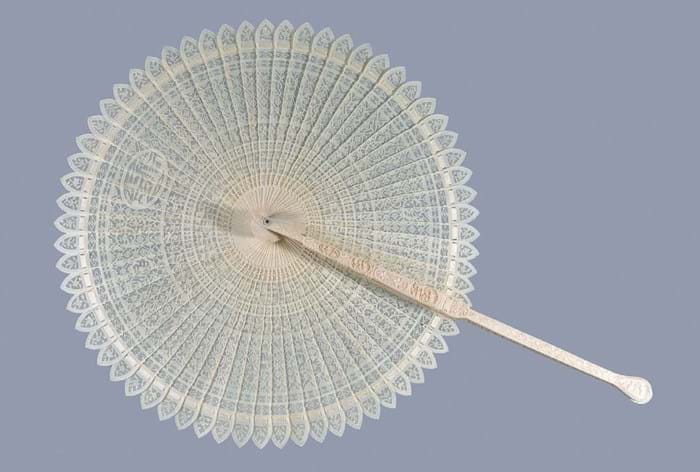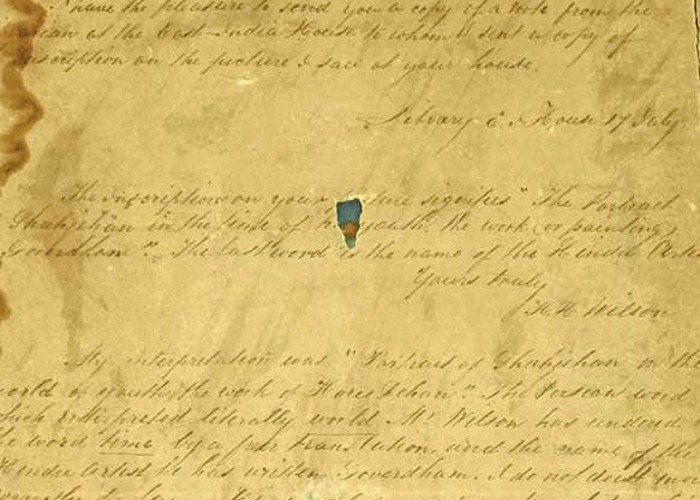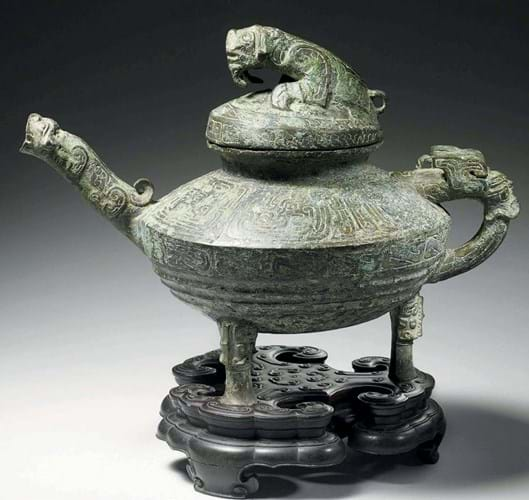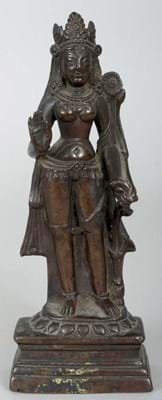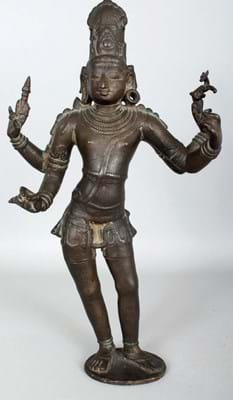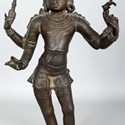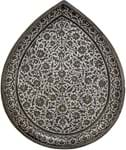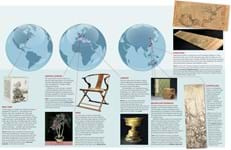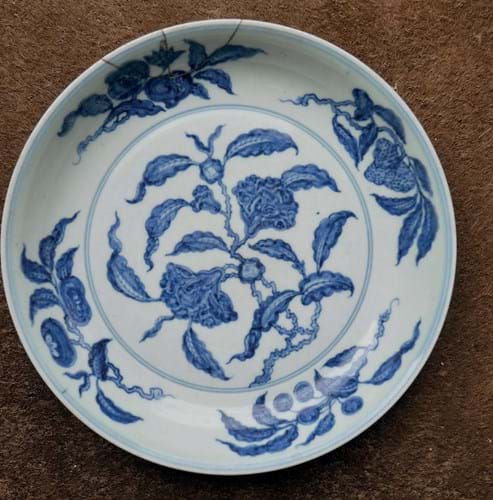
Ming blue and white dish
A buyer from Japan flew to the UK to purchase this Ming blue and white dish that surfaced at a small auction house in North Yorkshire in May. Summersgills Auctioneers in Easingwold had catalogued the dish, with a staple repair to the rim, as 19th century and expected it to sell for under £300. However, interest in the run-up to the auction had included a commission bid of £13,000.
The 12in (30cm) diameter shallow dish – brought in for sale by a local lady who had owned it for many years – is of a type first pioneered during the Xuande (1425-35) period.
The decoration includes a branch of flowering pomegranate to the centre and four fruiting branches including peach, lychee, persimmon and cherry blossom to the cavetto. Written in a horizontal line under the rim is a six-character reign mark for the emperor Chenghua (1465-87).
A handful of other Chenghua-marked dishes of similar size with this ‘pomegranate’ pattern are known, including that sold as part of the Greenwald collection by Christie’s Hong Kong in December 2010. It realised HK$2.66m ($344,000).
This helped explain the enthusiasm for this piece that, despite its condition issues, sold at £31,000 (plus 18% buyer’s premium).
Mask netsuke
A collection of mask netsuke amassed by Swiss entrepreneur Peter Müller was offered by Matthew Barton in west London in June. These miniatures of theatrical and religious masks – generally in wood but also in horn, pottery and iron – are a long-founded tradition in Japan.
However, they are not as familiar as the three-dimensional Katabori figures most people associate with netsuke.
Masanao of Kyoto ranks among the most important 18th century netsuke carvers but only four masks by him are recorded. The c.1780 signed example in the Müller collection was a 1½in (4cm) high mask of Kojo, the Shinto god of drunkenness. Made of boxwood with incised and black lacquered hair, it sold for £5600 (plus 24% buyer’s premium), just shy of top estimate, to a Continental collector who bought a number of pieces.
Pilgrim flask
This 13in (32cm) Iznik blue and white pottery pilgrim flask, c.1545-55, sold for £550,000 (plus 25/20/12.9% buyer’s premium) at Sotheby’s on April 25.
The only known example of this distinctive shape that imitates metal and leather prototypes, it is decorated in the early blue and turquoise of the mid-16th century with a fantastical mix of animals. Similar designs are seen in Balkan silverwork.
An old inventory number is probably that of the dealer and collector Stefano Bardini (d.1922). The estimate was £60,000-80,000.
Qur’anic Palimpsest
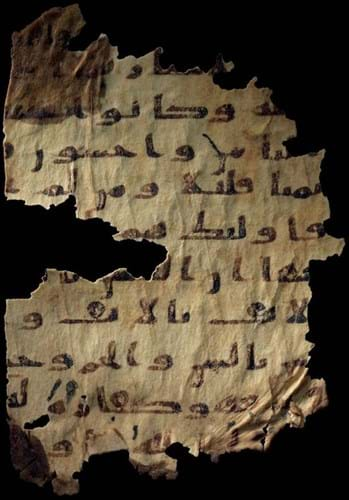
Nine fragmentary vellum folios of Qur’anic verse copied in the 8th century over earlier Christian text sold at Christie's for £490,000.
The opening lot of Christie’s Art of the Islamic and Indian Worlds sale in April was among the most eagerly contested of the series.
Estimated at £80,000-120,000, nine fragmentary vellum folios of Qur’anic verse copied in the 8th century over earlier Christian text sold at £490,000 (plus 25/20/12% buyer’s premium).
The discovery of this palimpsest, dating to just the second century of Islam, was made with the help of French scholar Eléonore Cellard.
The fragments are penned in a transitional style, between the later hijazi and early kufic scripts, with the gall ink words of a 2nd century Coptic bible still visible beneath. It was probably produced in Egypt at the time of the Arab conquest when writing materials were scarce.
Lotus vase
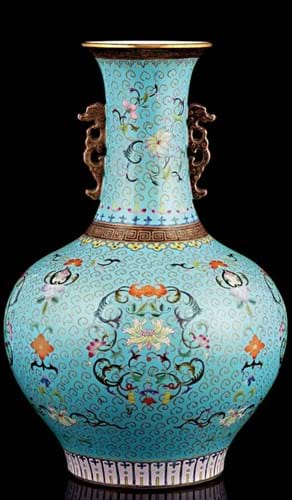
Lyon & Turnbull sold this unusual 13in (34cm) high 19th century famille rose ‘lotus’ vase at £160,000.
The London sale conducted by Lyon & Turnbull in May included this unusual 13in (34cm) high 19th century famille rose ‘lotus’ vase painted in imitation of cloisonné that sold at £160,000 (plus 25% buyer’s premium).
It came by direct family descent from the collection of the late William Crawford Gray (d.1918), the widely travelled founder of Gray’s Carpets in Ayr, Scotland.
Narcissus bowl
Duke’s May sale in Dorchester included a spectacular charity valuation day find.
An early Ming (Hongwu) Jun ware narcissus bowl was incised with a number one and carried a label for the George Eumorfopoulos (1863-1939) collection. After the well-known Merseyside-born collector died, the 14th century bowl was bought by collector ACJ Wall, and had then passed by descent.
It will now return to China after a private collector flew in for the sale, bidding £240,000 (plus 25% buyer’s premium).
Guanyin figure
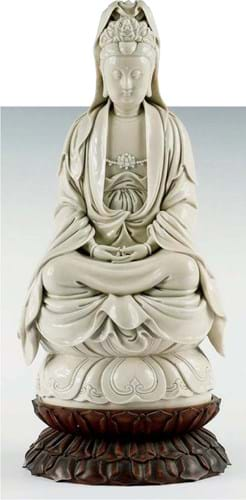
This figure depicting Guanyin seated sold at $650,000 at Thomaston Place Auction Galleries in Maine.
Although little is known of his life, the late Ming Dehua potter He Chaozong is almost unique in Chinese ceramic history as a named artist in an industry characterised by anonymous and controlled large scale production
Over a century later, he was revered by the Gazetteer of Quanzhou Prefecture of 1763 as the finest maker of mainly Buddhist white porcelain statuary that were “transmitted and treasured everywhere under heaven”.
This particular figure, depicting Guanyin seated in peaceful contemplation on a double lotus throne, stands 12½in (32cm) high with a rosewood lotus platform adding a further 2½in (7cm). It carries the double gourd seal of He Chaozong and was deemed of the period.
At Thomaston Place Auction Galleries (20% buyer’s premium) in coastal Maine on August 25, it sold at $650,000 (£500,000), some 10 times the top estimate.
The 'shoebox' vase

This imperial Qianlong (1736-1795) mark and period vase sold at Sotheby’s Paris saleroom at €14.2m (£12.5m).
An imperial Qianlong (1736-1795) mark and period vase, left to the vendor’s grandparents by an uncle and brought into Sotheby’s Paris saleroom in a shoebox, was knocked down at €14.2m (£12.5m) (plus 25/20/12.9% buyer’s premium) on June 12.
Against a modest €500,000-700,000 estimate, the lot took 20 minutes to set a new high for a piece of Chinese porcelain sold at auction in France.
The combination of form and yangcai enamel landscape decoration populated by deer, cranes and pine trees is particularly rare. Only one similar vase is known, although the imperial inventories twice mention a pair of vases to this design: one pair commissioned in 1765; the other ordered as a birthday gift in 1769.
The price is the second highest for Chinese art in France, after the €17.8m (£16.2m) bid in March 2011 at Toulouse auction house Labarbe for a €24m scroll depicting the army of the Qianlong emperor.
Jade beaker vase
This 17th century jade gu-form beaker vase offered by Roseberys in London on December 5 had a confidence-boosting provenance to a Christie’s Swire sale in 1991, when it was listed as the property of the TB Walker Foundation in Minneapolis.
Standing 10in (25cm) high and finely worked in a pale celadon stone of even tone with light brown inclusion, the subject matter of nine dragons in meandering clouds includes both an auspicious number and a reference to the nine sons of the dragon king, the mythological dispenser of rain.
Estimated at £4000-6000, but with bids online opening the contest at £30,000, the hammer finally fell at £48,000 (plus 23% buyer’s premium).
Cantonese fan
Although often associated with the export trade (they were imported from China as early as the mid-17th century), fans were also part of the paraphernalia of the Qing court.
Ivory was the key component. This c.1810 Cantonese ivory cockade brisé fan, offered at Dreweatts’ sale at Donnington Priory in May, measures a substantial 22in (55cm) high and is carved with an oval landscape reserve on a trellis ground. Pagodas and foliage adorn the two guard sticks.
It was guided at £800-1200, but strong Chinese interest – possibly triggered by the catalogue reference to a very similar fan in Neville J Irons’ book Chinese Imperial Fans – took bidding to £23,000 (plus 24% buyer’s premium).
Mughal painting
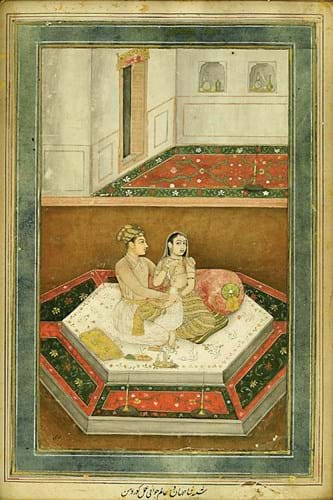
This 17th century Indian painting attributed to one of the best artists of the Mughal court sold for £42,000 at Sworders.
This 17th century Indian painting attributed to one of the best artists of the Mughal court sold for £42,000 (plus 23% buyer’s premium) at Sworders’ December sale in Stansted Mountfitchet.
It attracted plenty of interest against a £10,000-15,000 estimate, with the winning bid placed from Hong Kong.
The 10 x 6in (24 x 14cm) body colour miniature heightened in gold had been discovered in a private collection in Suffolk where it had been for more than one and a half centuries.
A letter dated 1846, stuck to the back of the painting, written by British Indian Army officer and manuscript collector Robert Emlyn Lofft (1782-1847), attributes the painting to Govardhan, one of the key Mughal royal painters of the first half of the 17th century. This picture is dated on stylistic grounds to the 1630s.
Lofft believed the scene represented the betrothal of the youthful Shah Jahan to Mumtaz Mahal c.1607-08. It is conceivable that this painting was, like the Taj Mahal mausoleum, a retrospective celebration of their loving union.
However, an alternative theory is that the prince, seated with his consort in a palace chamber, is Dara Shikoh, Shah Jahan’s favourite son. Born in 1615, he would have been around 15 when the picture was painted.
Summer Palace bronze
A rare Western Zhou bronze, taken when the Summer Palace was sacked by British troops in 1860, sold for £410,000 (plus 20% buyer’s premium) at the Canterbury Auction Galleries in April.
Only six similar archaic vessels, or ying, are known to exist, with this example christened ‘the tiger ying’ in reference to the auspicious felines that adorn the spout and cover.
It had been found in a Kent seaside bungalow, together with three Qing bronzes and an archive of letters and photographs relating to the military history of the Evans family of Monmouthshire.
Surviving letters from its erstwhile owner, Royal Marines Captain Harry Lewis Evans (1831-83), give a vivid account of the Second Opium War including details of the infamous looting of the Yuanming Yuan, or Old Summer Palace. The sale was challenged by China’s cultural heritage department, which said the bronze was an “illegally discharged cultural relic” and asked for it to be returned.
Falangcai bowl
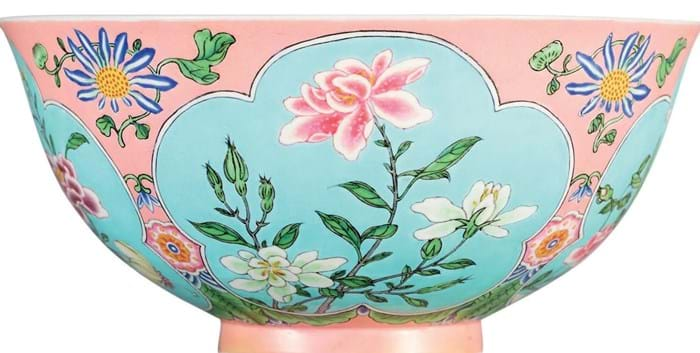
This 5¾in (14.5cm) diameter puce-enamel falangcai bowl, on the market for the first time in 30 years, sold at Sotheby's Hong Kong at HK$210m
This 5¾in (14.5cm) diameter puce-enamel falangcai bowl, on the market for the first time in 30 years, was expected to test the auction record for Chinese ceramics. The pre-sale expectations at Sotheby’s Hong Kong in April were around HK$200m.
The bowl has a Kangxi (1654-1722) yuzhi four-character mark, which translates as ‘made for the imperial use of…’, suggesting a close relationship with the imperial court. It is believed to have been made for the personal use of the emperor.
The provenance can be traced back to Shanghai in 1930 and it came from the collection of the Idemitsu Museum of Arts, Tokyo, where it had been since its last auction appearance in 1986.
The hammer price was HK$210m (£19.1m) (plus 25/20/12.9% buyer’s premium), short of a record but a new high for Kangxi porcelain.
Indian devi
Specialists who travelled to Surrey in April to view a collection of Indian and Himalayan bronzes formed by the late Andrew Soloman spotted a rarity among similar lots consigned from other properties.
Estimated at just £200-300, and considered by the auctioneers to be 19th century, a south Indian copper alloy devi sold to a US dealer in the room for £155,000 (plus 24% buyer’s premium) at John Nicholson’s in Fernhurst. The 8in (20cm) high figure was probably cast in the Tamil Nadu region c.1000-50. It depicts the earth goddess Bhudevi, a consort of Vishnu. She stands on a lotus pedestal which is cast in one piece with a rectangular base.
Movable bronze icons were an intrinsic part of the Chola dynasty temples. A larger Chola bronze from the 12th century was the highlight of the Soloman collection.
Purchased from Sotheby’s in December 1971 (the original sale invoice was sold with the lot), this 18in (45cm) bronze depicted the four-armed Shiva Vinadhara holding the battle-axe and antelope in his upper hands. Although lacking its lotus and pedestal base, it took £220,000 against hopes of £30,000-50,000.

